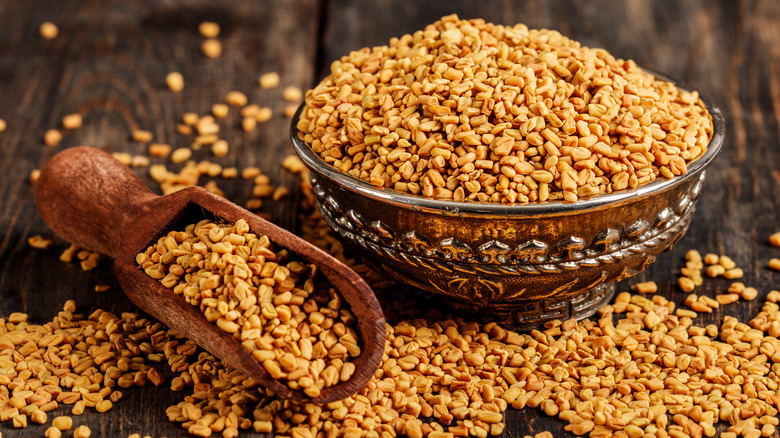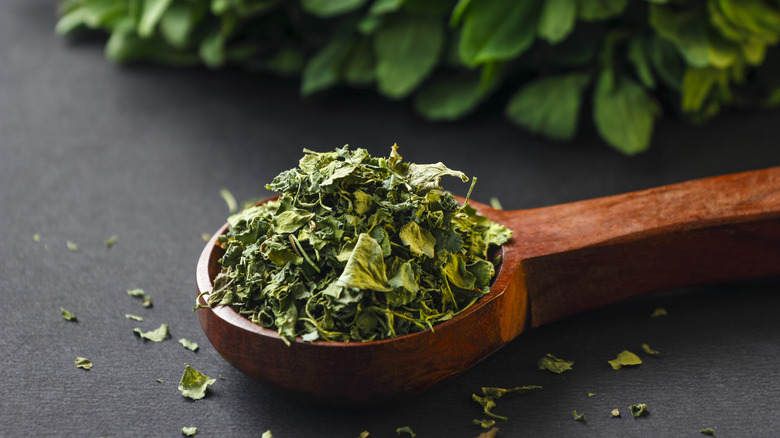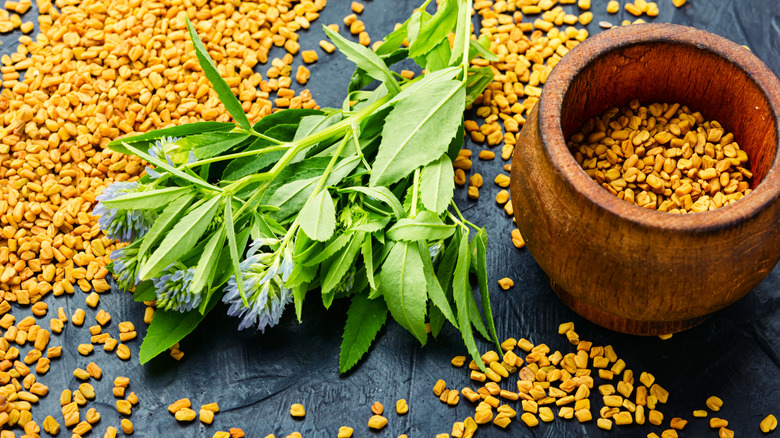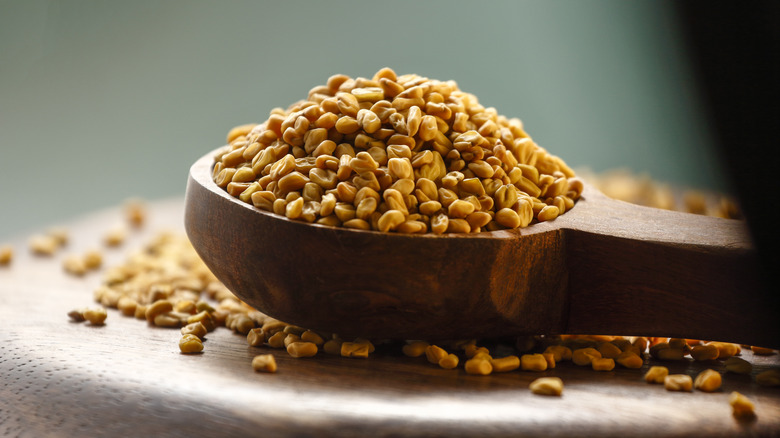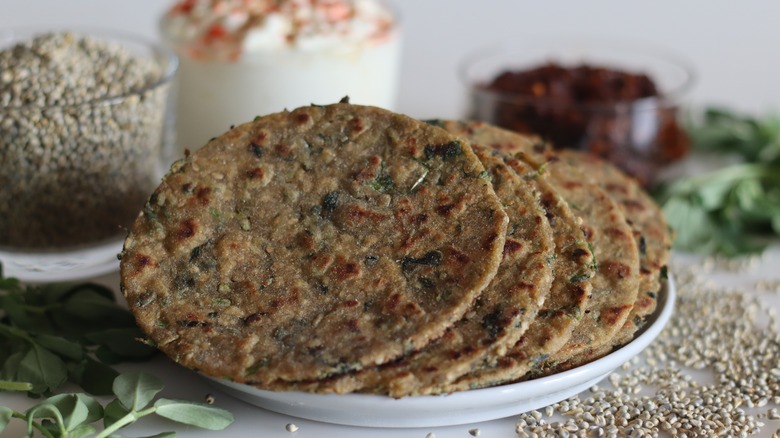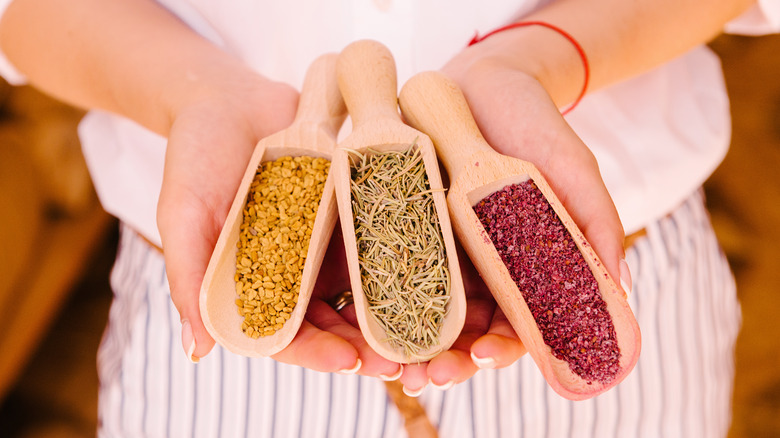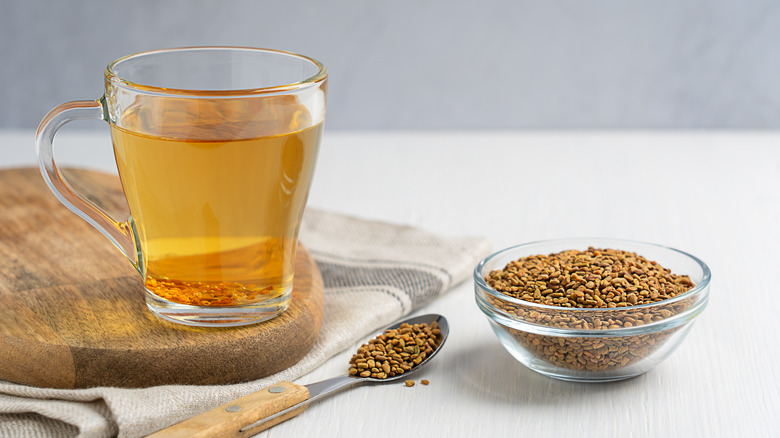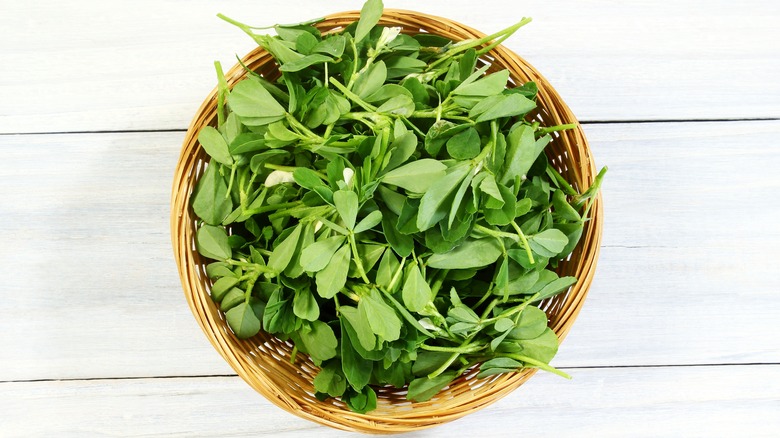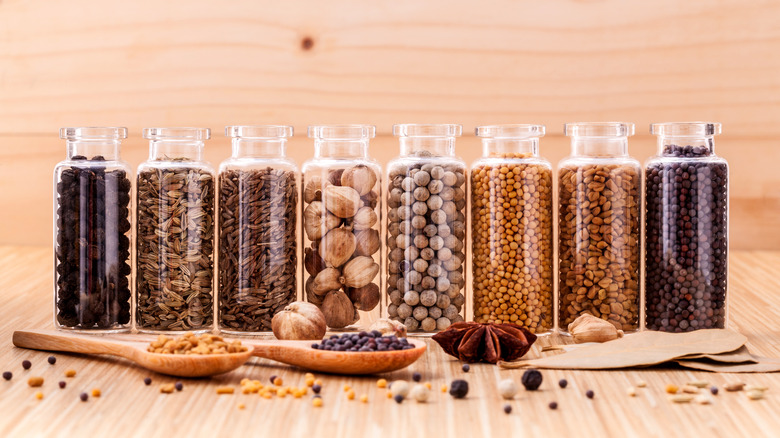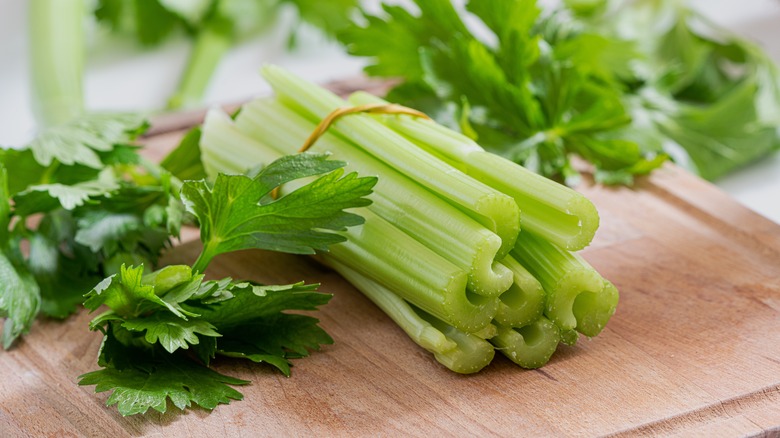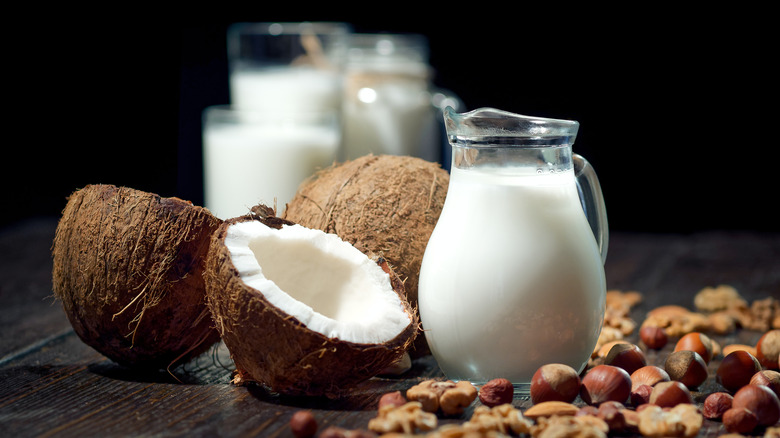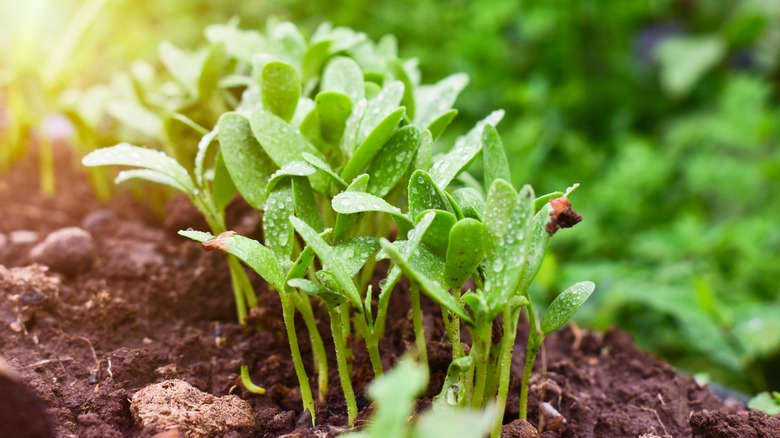What Is Fenugreek And What Does It Taste Like?
Fenugreek is among the more rare spices you might encounter, at least in many U.S. pantries, so it's natural to be curious about it and especially what it tastes like. You may already have some in your spice cabinet, but it's easy to just let it sit there when you're not sure how to use it. Even seasoned cooks sometimes don't know the full potential of this exotic spice. But don't let that be your excuse to sleep on this unique addition to your next dish.
It comes in seed, dried herb, and fresh herb versions, all of which are a little different from each other. We're here to explain what to expect from each so that you know how and when to use them. We'll also point out the best places to find this sometimes elusive spice so you can start experiencing it for yourself.
There's a lot more to know about fenugreek than you probably expect. So, stick around while we uncover all the information you ever wanted to know about the versatile spice and herb known as fenugreek.
What is fenugreek?
Fenugreek is a spice that comes from an annual herb in the Fabaceae (or Leguminosae) family, where we get legumes like soybeans and peanuts. It is used as both an herb and spice, since both the leaves and seeds are edible. It's consumed as a tea, while its extracts can be found in some soaps and cosmetics.
This plant has a history that goes back several millennia. Archeologists have found burned seeds in Iraq dating to 4,000 B.C. as well as in Egyptian tombs, including Tutankhamun's tomb from around 1,324 B.C. Roman statesman Cato the Elder mentioned them as a feed crop for cows, which is perhaps where it got the nickname "Greek hay."
When most people think of fenugreek, they think of its role in Indian cuisine. After all, India produces the vast majority of the world's fenugreek. However, the herb is likely native to the Mediterranean and southern Europe. It's also commonly grown in northern Africa and western Asia. The plants are about three feet tall with green leaves, triangle-shaped yellowish-white flowers (where it gets its Latin name, meaning "little triangle"), and six-inch seed pods.
The difference between fenugreek leaves and seeds
Nearly all of the fenugreek plant is edible, with the leaves and seeds flavored for use in the kitchen. However, as you can imagine, fenugreek leaves and seeds have different flavors and usages. The seeds are considered to be spice, while the leaves can function like a leafy green vegetable when raw and an herb when dried. They're not necessarily interchangeable, but both forms are typically bittersweet, lending a similar maple-like flavor profile to foods. The leaves also have a unique celery-like taste.
Because the seeds are hard, they need to be processed before you can use them, usually by grinding them into a powder or softening them with heat or water. Fenugreek leaves don't need extra processing, no matter if you're using them fresh or dried. While you can use both forms of fenugreek in a variety of foods, only the seeds will help thicken liquids.
How is fenugreek processed?
Fenugreek leaves are the first part of the plant that is harvested, with the leaves ready 30 to 40 days after planting. However, it's important to note that the leaves become bitter after the plant flowers, so they must be picked in time. After harvesting, they're washed. They only have a four- to five-day shelf life, so they must be used right away, frozen, or dried. Drying, which can help the leaves to last for a year or two, involves blanching the leaves, drying them in the sun or under gentle heat, and then sometimes grinding them into a powder before packaging.
Somewhere around the 50- to 70-day mark, the plant will stop flowering and begin to produce seed pods, which are ready to harvest after the plant is spent and the pods start to turn yellow. After harvesters remove the pods, they thresh and winnow them to separate the pods from the seeds, as well as dust and straw. Some producers have machines that can help remove stones and other debris as well as separate the seeds into different sizes. Before packaging, the seeds need to dry in the sun or with a mechanical dryer. Seeds may also be ground before packaging.
What does fenugreek taste like?
Fenugreek seeds have a slightly sweet, burnt sugar or maple syrup flavor. They're also a tad bitter. The maple flavor of fenugreek leaves is a common addition to imitation maple syrups, so you're likely already familiar with its taste without knowing it.
Like the seeds, fenugreek leaves are bitter and have a mildly bitter flavor that is similar to maple syrup. The leaves also call to mind an earthy version of celery or fennel, flavor notes that the plant's seeds lack. The chemical that gives fenugreek its distinctive sugary maple flavor is sotalone, which doesn't break down after consumption. This is why your sweat may start to smell a bit like maple syrup if you consume enough of the seeds or leaves.
The flavor of fenugreek pairs nicely with many spices you often see used in Indian cuisine like ginger, cumin, cardamom, curry powder, and turmeric. It also works well with delicate herbs like cilantro, basil, and parsley. You'll find that fenugreek makes tomato dishes taste richer, while it pairs nicely with acidic ingredients to cut a dish's bitterness.
How to cook with fenugreek
Broadly speaking, fenugreek seeds and dried leaves are used as spices. Meanwhile, the raw leaves are used more like a vegetable. The seeds need to be prepared before joining a dish because they are hard and have saponins that make them bitter. Some cooks soak the seeds overnight or reach for a pressure cooker or pot of boiling water. Others sprout them or dry fry the seeds for a few minutes. Any of these methods should help to soften the seeds and remove some of the bitterness.
Because it has a strong and distinctive flavor, you'll also often find the seeds in rubs and marinades as well as Indian curries and chutneys. They're also useful in sauces, stews, and soups because of their thickening properties. The seeds are also a common component of the Indian spice mixture garam masala, a seasoned clarified butter from Ethiopia called niter kibbeh, and an Ethiopian spice mix called berbere.
Meanwhile, you can cook with both raw and dried fenugreek leaves. The raw leaves are common in aloo methi (potato and fenugreek curry), methi dal (fenugreek lentil stew), green salads, an Indian flatbread called methi thepla, and methi chutney. Dried, the leaves work more like an herb you can add at the last minute to curries, soups, sauces, and other dishes.
Where to buy fenugreek
Finding fenugreek can be challenging since it's not as common as other spices and herbs in a typical American grocery store. While you may be able to find fenugreek in your local grocery if you're lucky, you are more likely to find it in smaller stores, especially ones that sell bulk spices like health food stores, dedicated spice vendors, international markets, or Indian markets. If you're at an Indian market, you may find it listed as "methi" instead of "fenugreek." If you can't find it locally, there are also plenty of places you can buy it online.
If you're at a store looking for seeds or dried fenugreek, naturally look in the spice section of the store. If you're seeking out the leaves, you're unlikely to find them in the produce aisle, given their sort shelf life, which is mere days after they have been harvested.
The potential health benefits of fenugreek
Modern research has indicated that consuming fenugreek may have a lot of positive effects. It's one of the world's oldest traditional medicines. mentioned in the ancient Egyptian Ebers Papyrus back in around 1,500 B.C. It has been used in traditional medicine for many purposes, including aiding digestion, increasing milk supply for breastfeeding, and helping control diabetes in multiple cultures and countries.
A study published in the Journal of Alternative and Complementary Medicine indicates that fenugreek tea may help increase breastmilk production. Another published in Phytotherapy Research suggests that it may be effective for increasing muscle strength, while one in the Galen Medical Journal notes that it could help diabetics control their blood glucose levels.
Still another study in Phytotherapy Research suggests fenugreek can help people feel full longer to help with weight control. Another published piece in Phytotherapy Research shows it could help with heartburn. Plus, a study in the Journal of Ethnopharmacology shows promise for having a positive effect on cholesterol. So, there are many good reasons to ask your doctor if you should add it to your diet. However, a 2010 study in the Journal of Proteomics says you may want to be wary of consuming fenugreek if you have a peanut allergy, since it is a legume.
Varieties of fenugreek
Fenugreek has a lot of variety. That's because the Trigonella genus contains 260 unique species, though there are three types of fenugreek in particular that are most popular among growers: regular fenugreek (Trigonella foenum-graceum), jagged fenugreek (Trigonella laciniata), and Egyptian fenugreek (Trigonella hamosa). That's not all, however, as Georgian cuisine often uses blue fenugreek (Trigonella caerulea), which is milder than the regular variety. Blue fenugreek is also common in some Swiss rye bread and a type of Swiss cheese known as schabziger.
There are even sub-varieties within the same species. Fenugreek farmers grow certain plants based on a variety of factors, including how quickly they grow, disease and pest tolerance, yield, how well they tolerate artificial irrigation, where they can grow, and their oil content. For example, the Pant Ragini variety of fenugreek contains up to 2.5% essential oil, making it useful for medicinal purposes. The plants tend to look different, as do the seeds, which can be a range of colors, including yellow, golden, or brownish-orange.
How to store fenugreek
You should store fenugreek seeds or dried fenugreek leaves as you do with many other spices: in an airtight container kept in a dark, dry place. It's best to store the seeds whole rather than grinding them, since the flavor of the ground variety will start to fade relatively quickly. Whole seeds will keep their quality for around three years, whereas ground seeds keep for only a few months. The dried leaves will stay good for about a year if stored properly.
When it comes to raw fenugreek leaves, they only last a few days, so treat them with care. It's best not to wash them until you're ready to use them, as washing removes oils that help keep them fresh. If keeping them whole, wrap the stalks in a damp paper towel and place them in a plastic bag. Keep them away from foods like tomatoes and potatoes, which release ethylene gas as they ripen. Refrigerated, the leaves may last up to a week.
If you don't plan to use the leaves within a few days, it's best to freeze them. First, fry them in a little oil and, once cool, freeze them in an airtight, freezer-safe container.
What to use as a substitute for fenugreek
There's no perfect substitute for fenugreek. However, you can hit on similar flavor notes to approximate the experience of consuming fenugreek in seed, dried herbs, or raw green form. Your best bet to mimic fenugreek seeds is to make a mixture of yellow mustard seeds and maple syrup. The mustard seeds provide an earthy flavor, while the maple syrup will lend sweetness to what you're cooking. Plain maple syrup without mustard is also an option. However, you'll want to use the syrup sparingly, so as not to overwhelm the dish. Another option is to use fennel seeds. However, use them sparingly since they have a licorice-like flavor and can be sweeter than fenugreek.
The leaves have a few substitutes, too. If you have fenugreek seeds on hand, substitute ½ teaspoon of ground seeds for a teaspoon of dried herbs. Since raw fenugreek leaves have a celery-like flavor, you can also use celery leaves in equal amounts of raw leaves, while you will need one to two tablespoons of fresh leaves to substitute for a tablespoon of dried fenugreek. If you want to mimic the maple flavor of fenugreek, you can also add a touch of maple syrup here as well.
How to salvage a dish if you add too much fenugreek
Because of the bitter component, it's best to proceed with caution if you're experimenting with fenugreek. Adding too much can result in a dish that is overly bitter or has too much maple-like flavor.
But if you go to far, all is not lost. There are several ways to cut the bitterness, namely diluting the dish with more liquid. Creamy liquids are an especially good choice because they help to absorb and hide overwhelming flavors. So, you try adding yogurt, cream, or coconut milk to the dish to see if it helps balance out the bitterness. Acids like lime or lemon juice can also help to cut overly bitter components of fenugreek. If you already have enough liquid, you can always remove half and replace it with new liquid. With either of these methods, you might end up needing to add back other spices that were diluted or overwhelmed.
Another option is to use a sweetener like sugar or maple syrup to mask fenugreek's bitterness. However, be conservative to keep from over-sweetening your dish. Other flavors can also help to tame fenugreek's flavor, including dried mint, fennel seeds, or ground coriander.
Can you grow your own fenugreek?
It's entirely possible to grow your own fenugreek, and it can make an interesting and unique addition to your herb garden. Whether or not the plant acts as an annual or perennial depends on where you live. In U.S. growing zones nine through 11, it will grow as a perennial, meaning you don't have to replant it each year. The plants need to stay moist in well-drained soil, so they will likely require watering twice a day if you try to grow them during the hot summer months. For many gardeners, this means that fenugreek can be a high-maintenance plant. However, you can grow them in a container instead of planting them in the ground, which may make the process of growing them more manageable.
If you're up to growing it, fenugreek is a versatile plant. You can harvest multiple parts from it during different points in its life cycle. If you want fenugreek sprouts, it only takes three to five days until you will begin to spot seedlings emerge. Full-sized leaves will be ready to harvest in 30 to 40 days. However, the leaves won't taste good once the plant begins to put out flowers, so you'll only be able to harvest them for 40 to 60 days. You'll have to wait a bit longer for seeds, as you must allow the seed pods to turn yellow before the seeds inside are ready to harvest, which may take three to five months.
